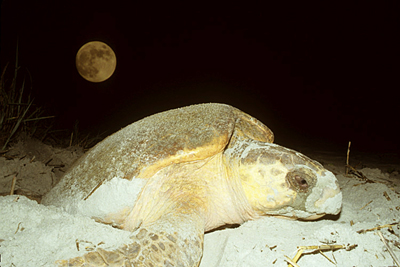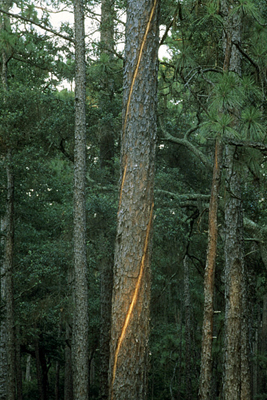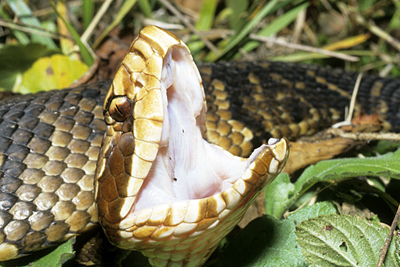 May is when the sea turtles start nesting on Cumberland Island. At the end of the month, forty three nests had already been located. By the end of the summer there will be approximately two hundred nests on the beach if it is a normal year. These are loggerhead turtles that average two to three hundred pounds. They prefer the upper beach and foredunes as nesting sights; most of them will come ashore on the last hour of an incoming tide so they won’t have to crawl a long way to a suitable location; also, more turtles nest on moon lit nights when they can see the silhouette of the shorline.
May is when the sea turtles start nesting on Cumberland Island. At the end of the month, forty three nests had already been located. By the end of the summer there will be approximately two hundred nests on the beach if it is a normal year. These are loggerhead turtles that average two to three hundred pounds. They prefer the upper beach and foredunes as nesting sights; most of them will come ashore on the last hour of an incoming tide so they won’t have to crawl a long way to a suitable location; also, more turtles nest on moon lit nights when they can see the silhouette of the shorline.
Female turtles will dig a deep round hole with their back flippers and deposit anywhere from fifty to over one hundred and fifty eggs in the cavity. After covering the nest with sand the mother turtle returns to the sea and the eggs are left alone to hatch which takes about sixty days of incubation time. The sex of the young will be determined by the temperatures in the nest. For example: warmer nests in the high 80’s will produce mostly males.
Turtle nests are targets for predators. On Cumberland, raccoons, feral hogs and ghost crabs would all like to feed on the nutrient rich eggs. The National Park Service conducts a turtle research program that locates and covers nests with wire cages that will usually keep out raccoons and hogs. Crabs however are harder to guard against. After a nest hatches the baby turtles dig their way to the surfact and easily crawl through the protective wire cages to the open beach. Predation on young turtles from the beach to the open sea is heavy as they try to reach the large floating rafts of sargassum weed that can be hundreds of miles from shore in an area known as the Sargasso Sea. If a young turtle can make it that far it has a much better chance of survival as sargassum weed provides plenty of hiding areas from large predators. Once a sea turtle gains some size there is less chance of it becoming a meal for another sea animal. However, Loggerhead turtles develop slowly, at least they keep their close association with the protective Sargassum for up to ten or twelve years; it’s sometime between twenty and thirty years when Loggerheads become sexually mature. At this point in their lives they will return to the beaches where they were hatched; this time to nest themselves and repeat a process that has been occurring on wild beaches around the world for over 150 million years. In recent times though sea turtles have become threatened and endangered by man; a relative new comer with high impact on ocean eco-systems. Sea turtles now face a gauntlet of entanglement devices put into the sea by man such as nets and fish line. Plastic bags floating in the water also kill turtles as they mistake them for jellyfish; a favorite food source. Biological and chemical toxins from polluted waters have a damaging effect on turtles as well as other marine species.
Probably the single largest threat to sea turtles alone is the loss of suitable nesting habitat. These ancient reptiles evolved on wild undisturbed beaches; more and more of these areas now are becoming obstructed with human development; much of which is not compatible with sea tutle nesting activity. Cumberland Island however still has over seventeen miles of wild beach available to nesting turtles. This, along with help from the turtle research team is a positive development in favor of these endangered animals.
























You must be logged in to post a comment.